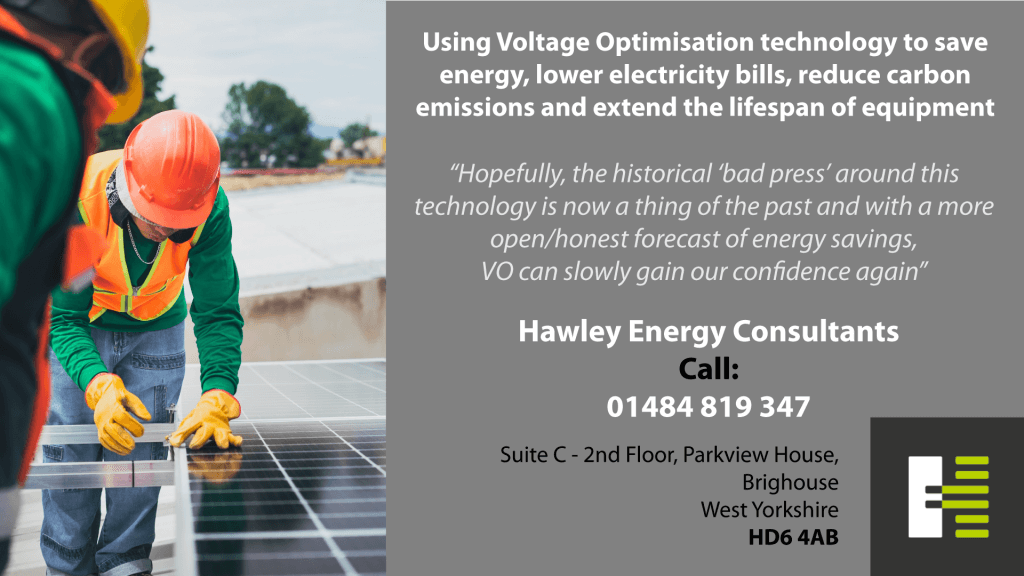
It’s been some time since I have spoken at any length about Voltage Optimisation (VO) but a recent increase in marketing activity from equipment manufacturers is pulling me back in to this interesting sector that isn’t without it’s challenges and certainly suffers from (some partially unfair) bad press.
Voltage optimisation is a technology that reduces and stabilises the voltage supplied by the National Grid to a lower and more suitable level for the electrical equipment in a home or business premises. This can help save energy, lower electricity bills, reduce carbon emissions, and extend the lifespan of the equipment.
Keeping things as simple as possible, the technology essentially exists in the UK as mains supply is an AC voltage frequency of 50Hz and 230V, but it can fluctuate between 216V and 253V 3. Voltage optimisation can reduce the excess voltage and harmonise the power flow to match the optimal level for the equipment.
There are several different types of voltage optimisation units available varying from a basic step down transformer type arrangements to servo driven dynamic units right up to thyristor driven units. Careful consideration of all the options available is a key factor in choosing the best solution for you and your application. Some also provide online, remote monitoring capabilities, providing full visibility of asset performance, savings, and more.
According to BEAMA, the UK trade association for manufacturers and providers of energy infrastructure technologies and systems, using a voltage optimiser can help with average energy savings of up to 13% but in my experience (having used and monitored almost every variant of the technology), a more real work expectation would be in the region of 6%.
VO can sit well as part of most energy reduction strategies as either a ‘quick fix’ solution in the early stages or as a ‘fine tune’ as all other opportunities have been expended. Both have their own advantages/disadvantages – installing the equipment early will produce a ‘quick win’ (providing the correct surveys & analysis has been done) but the capital cost will almost certainly be lower if it is installed once a sites maximum demand has been reduced, reducing the size of the unit itself but savings would arguably be lost/lower.
As Chair of VOICE (Voltage Optimisation Industry Council for Excellence), we established some ground rules that hold true to this day, the successful deployment of VO depends on some careful analysis, engineering and customer around future requirements.
The key stages are:
- Choose your consultant, advisor carefully
- VO doesn’t NOT work for everyone and ensuring your chosen auditor is willing to take this on board and advise you impartially
- Logging of voltage on site
- Consideration should be given to season, time of day, ambient temperatures, operational loads
- Survey of Electrical Equipment
- Different types of equipment will respond differently to a lower voltage, some will continue to draw the same load (kettles for example) and not produce a saving where other loads (such as smaller motors without variable speed drives) will.
- Assessment of Maximum Demand
- This will help the most suitable unit size be assessed – as a rule of thumb, you should allow a minimum of 20% to any historical peak load you can already see
- Customer Guidance
- It’s vitally important that an assessment is made of the end users future plans.
- If you have an 800A incomer but a max demand of 400A, you may choose to install a 600A VO unit that you may need to remove/upgrade in the future if the plans to add in EV charging points next year hasn’t been teased out of the building occupier and their team.
- It’s vitally important that an assessment is made of the end users future plans.
For larger installations, it’s also worth considering the relevance of a ‘wrap-around’ bypass arrangement that allows the VO unit to be worked on or even replaced. Care will need to be taken when de-energising/re-energising but in circumstances where the continuous supply is critical, these can be a worthwhile (if not costly) investment.
Solar continues to feature heavily in most plans to reduce reliance on the grid/reduce cost, and VO can help to minimise the impact of the higher associated voltages. In many cases, installing multiple solutions into a site simultaneously can be problematic but in this case, the 2 work well together.
Hopefully, the historical ‘bad press’ around this technology is now a thing of the past and with a more open/honest forecast of energy savings, VO can slowly gain our confidence again. As a solution, this technology can work well and the added value from extended life expectancy of electrical equipment connected to a lower voltage shouldn’t be ignored (but arguably shouldn’t be built into any savings forecasts).
Hawley Group has extensive proven history of successfully delivering Voltage Optimisation as a solution in circumstances where the ROI is realistic and can be closely tracked.
We are independent energy consultants and if you’d like one of our team to investigate suitability for you, please get in touch!
Call Hawley Energy Consultants 01484 819 347

